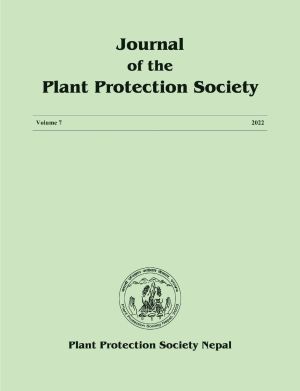Controlling Downy Mildew in Buckwheat using Fungicide
DOI:
https://doi.org/10.3126/jpps.v7i01.47292Keywords:
Downy Mildew, Peronospora fagopyri, Fungicides, Chemical controlAbstract
Downy mildew caused due to Peronospora fagopyri is the most important fungal pathogen that contributed to significant yield loss in buckwheat genotypes. Efficacy of six fungicides namely SAAF (Carbendazim 12% + Mancozeb 63%) @ 3 g/l, Krilaxyl (Metalaxyl 8%+ Mancozeb 64% WP) @ 2 g/l, Bavistin (Carbendazim 50% WP) @ 2g/l, Hexazol (Hexaconazol 5% SC) @ 2 g/l of water, Dithane M-45 (Mancozeb 75% WP) @ 2.5 g/l and Cyclon (Tricyclazol 75% WP) @ 2 g/l of water against one control with three replicates were tested at Hill Crops Research Program, Kabre, Dolakha during summer season of two consecutive years 2019 and 2020 against downy mildew of buckwheat. First spray was given just after the appearance of disease symptom in the field. Two sprays were given at an interval of 10 days. Data were recorded before every spray using 1-9 scoring scale on 10 randomly tagged plants/plot. All the fungicides were found to be effective in controlling the disease. SAAF was the most effective in reducing the disease severity (≤30%) and enhancing yield, followed by Dithane M-45 when compared to the unprotected control with highest disease severity (>75%). The use of these fungicides is recommended in an integrated disease management strategy, incorporating host resistance and cultural practices.
Downloads
Downloads
Published
How to Cite
Issue
Section
License

This work is licensed under a Creative Commons Attribution-NonCommercial 4.0 International License.
This license enables reusers to distribute, remix, adapt, and build upon the material in any medium or format for noncommercial purposes only, and only so long as attribution is given to the creator.

